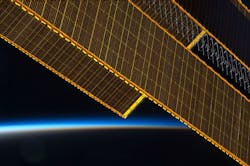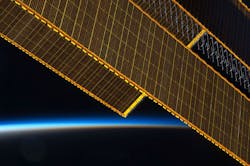NASA awards solar array contracts, plans additional opportunities related to deep space exploration
WASHINGTON, 17 March 2016. Officials in charge ofNASA's Game Changing Development (GCD) program have selected four proposals to develop radiation-tolerant, radiation-hardened, and rad-hard solar array technologies to aid spacecraft in exploring destinations well beyond low-Earth orbit, including Mars.
NASA's future deep space missions will require solar arrays that can operate in high-radiation and low-temperature environments. Developing a new generation of solar power technologies that focuses on these attributes will improve mission performance, increase solar array life, and may allow solar-powered vehicles to explore deeper into space than ever before.
"These awards will greatly enhance our ability to further develop and enhance LILT (low-intensity low temperature) performance by employing new solar cell designs," says Lanetra Tate, the GCD program executive in NASA's Space Technology Mission Directorate. "The ultimate goal of increasing end of life performance and enhanced space power applications will greatly impact how we execute extended missions, especially to the outer planets."
Initial contract awards are as much as $400,000, providing awardees with funding for nine months of system design, component testing, and analysis.
After completing the initial nine months, NASA anticipates a second phase, and may select up to two of these technologies to receive up to $1.25 million to develop and test their hardware during the second stage of the project. In the third and final phase of the project, one awardee may be asked to continue the development and deliver scalable system hardware.
The four proposals selected for contract negotiations are:
Transformational Solar Array for Extreme Environments -- Johns Hopkins University Applied Physics Laboratory of Laurel, Maryland
Micro-Concentrator Solar Array Technology for Extreme Environments – The Boeing Company of Huntington Beach, California
Solar Array for Low-intensity Low Temperature and High-Radiation Environments, NASA's Jet Propulsion Laboratory in Pasadena, California
Concentrator Solar Power Systems for Low-intensity Low Temperature and High Radiation Game Changing Technology Development -- ATK Space Systems of Goleta, California
Thirteen proposals were submitted by NASA centers, laboratories, research groups, and industry in response to the Extreme Environment Solar Power Appendix to the SpaceTech-REDDI-2015 NASA Research Announcement.
NASA's Langley Research Center in Hampton, Virginia, manages the GCD program for the agency's Space Technology Mission Directorate in Washington.
During the next 18 months, the directorate will release more solicitations with the goal of making significant investments that address high-priority challenges for achieving safe and affordable deep-space exploration.
You might also like:
Subscribe today to receive all the latest aerospace technology and engineering news, delivered directly to your e-mail inbox twice a week (Tuesdays and Thursdays). Sign upfor your free subscription to the Intelligent Inbox e-newsletter at http://www.intelligent-aerospace.com/subscribe.html.
Connect with Intelligent Aerospace on social media: Twitter (@IntelligentAero), LinkedIn,Google+, and Instagram.
Intelligent Aerospace
Global Aerospace Technology NetworkIntelligent Aerospace, the global aerospace technology network, reports on the latest tools, technologies, and trends of vital importance to aerospace professionals involved in air traffic control, airport operations, satellites and space, and commercial and military avionics on fixed-wing, rotor-wing, and unmanned aircraft throughout the world.



